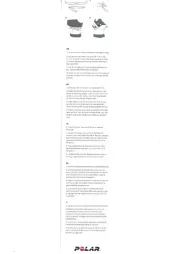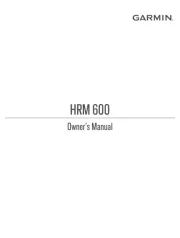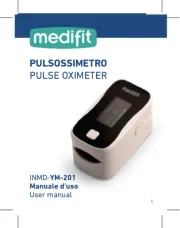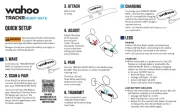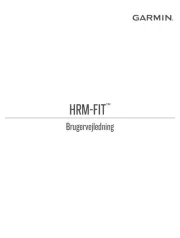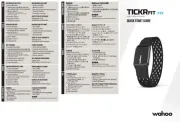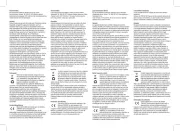Cleaning and disinfection
Troubleshooting
Specification
1. Please clean the surface of the device before
using. Wipe the device with medical alcohol
(70% isopropyl alcohol)first, and then let it dry
in air or clean it by dry clean fabric. When clean-
ing the device with water, the water tempera-
ture should be lower than 60ºC
2. Using the medical alcohol to disinfect the prod-
uct after use, prevent from cross infection for
next time use.
3. The best storage environment of the device
is - 20ºC to 70ºC ambient temperature and not
higher than 95% relative humidity.
4. Users are advised to calibrate the device termly
(or according to the calibrating program of
hospital). It also can be performed at the state-
appointed agent or just contact us for calibra-
tion.
Symptoms CorrectionsCheck points
SpO2 or
pulse rate
cannot
displayed
Applied nger
improperly.
Place the nger
properly and try
again.
SpO2 is too low to
detect
Try again; go to
consult with your
physician if you
are sure the de-
vice works well.
SpO2 or
pulse rate
are not
displayed
stably
Applied nger
improperly.
Place the nger
properly and try
again.
Finger is shaking or
body is moving.
keep body
steady
No display
when
button is
pressed
Batteries run down Replace with
new batteries
Batteries not in-
serted correctly.
Re-insert bat-
teries
The display
disappears
suddenly
The device will
auto power o
when it gets no
signal.
Normal
Low battery Replace with
new batteries
Note: If the unit does not work, return it to
your dealer. Under no circumstance
should you disassemble and repair the
unit by yourself.
SpO2
Measuring range 35%~99%, (the resolution is 1%).
Accuracy 70%~99%: ±2%, Below 35~69%:
unspecied.
Optical Sensor Red light (wavelength is 660nm),
Infrared (wavelength is 905/880nm)
Pulse
Measuring range 30bpm~250bpm (the resolution is
1 bpm)
Accuracy ±3bpm
Power source AAA × 2 (Alkaline)
Battery life Continually for 16 hours with two
alkaline batteries
Operating
Condition
Temperature: 5 (41ºC~40ºC ºF ~
104ºF), Relative Humidity: 15-95%
(non condensing), Atmospheric
pressure: 700hPa ~ 1013hkPa,
Attitude: -1,280 to 12,000 feet
(-390m to 3,658m)
Storage
Condition
Temperature: -25ºC~+70ºC(-
13ºF ºF~ 158 ), Relative humidity:
15-90%(non condensing),
Atmospheric pressure: 700hPa ~
1013hkPa, Attitude: -1,280 to 12,000
feet (-390m to 3,658m)
Dimensions 63.5(L) × 34W) × 35(H) mm
Weight About 37g (without the batteries)
Standards IEC60601-1-2, Class B, IEC60601-1,
Type BF, ISO80601-2-61
Type BF applied parts
IP Classication IP22: Protection against harmful
ingress of water and particulate
matter
Note: 1. Do not sterilize, autoclave or immerse this
device in liquid. Do not pour or spray any
liquids onto the device.
2. Do not use caustic or abrasive cleaning
agents, or any cleaning agent containing
ammonium chloride or isopropyl alcohol.
- A functional tester cannot be used to access the
accuracy of a pulse oximeter monitor.
- Do not self-diagnose or self-medicate on the
basis of the measurements without consulting
your doctor. In particular, do not start taking
any new medication or change the type and/or
dosage of any existing medication without prior
approval.
- Do not look directly inside the housing during
the measurement. The red light and the invisible
infra-red light in the pulse oximeter are harmful
to your eyes.
- This device is not intended for use by people
(including children) with restricted physical, sen-
sory or mental skills or a lack of experience and/
or a lack of knowledge, unless they are super-
vised by a person who has responsibility for their
safety or they receive instructions from this per-
son on how to use the device. Children should
be supervised around the device to ensure they
do not play with it.
- Neither of the displays for the pulse wave and
pulse bar allows the strength of the pulse or
circulation to be evaluated at the measurement
site. Rather, they are exclusively used to display
the current signal variation at the measurement
site and do not enable reliable diagnostics for
the pulse.
Model: SB100
www.rossmax.com
Fingertip Pulse Oximeter
IN0SB1000000000XX
RI_IB_SB100_EN_SW_ver1708
Warranty Card
This instrument is covered by a 1 year guarantee from the date of purchase, batteries
and accessories are not included. The guarantee is valid only on presentation of the
guarantee card completed by the dealer confirming date of purchase or the receipt.
Opening or altering the instrument invalidates the guarantee. The guarantee does
not cover damage, accidents or non-compliance with the instruction manual. Please
contact your local seller/dealer or www.rossmax.com.
Customer Name: __________________________________
Address: _______________________________________
Telephone: _____________________________________
E-mail address: ___________________________________
Gender: Male Female Age: _____
Product Information: ______________________________
Date of purchase: _________________________________
Store where purchased: _____________________________
Rossmax InnoTek Corp.
12F., No. 189, Kang Chien Rd., Taipei, 114, Taiwan.
Rossmax Swiss GmbH,
Tramstrasse 16, CH-9442 Berneck, Switzerland
WARNING: The symbol on this product means that it's an electronic product
and following the European directive 2012/19/EU the electronic products have
to be dispose on your local recycling centre for safe treatment.
EMC guidance and manufacturer’s declaration
Recommended separation distances between portable and mobile RF communications equipment and the ME equipment
The Finger-tip pulse oximeter is intended for use in an electromagnetic environment in which radiated RF disturbances are
controlled. The customer or the user of the Finger-tip pulse oximeter can help prevent electromagnetic interference by main-
taining a minimum distance between portable and mobile RF communications equipment (transmitters) and the Finger-tip
pulse oximeter as recommended below, according to the maximum output power of the communications equipment.
Rated maximum output
power of transmitter / W
Separation distance according to frequency of transmitter / m
150 kHz to 80 MHz , d=[3.5/
V1]√P 80 MHz to 800 MHz , d=[3.5/
E1]√P 800 MHz to 2,5 GHz , d=[3.5/
E1]√P
0.01 0.12 0.12 0.23
0.1 0.37 0.37 0.74
1 1.17 1.17 2.33
10 3.7 3.7 7.37
100 11.67 11.67 23.33
Declaration – electromagnetic emissions and immunity – for EQUIPMENT and SYSTEMS that are not LIFE-SUPPORTING and
are specied for use only in a shielded location
The Finger-tip pulse oximeter declaration – electromagnetic immunity
The Finger-tip pulse oximeter system is intended for use in the electromagnetic environment specied below. The customer
or the user of the Finger-tip pulse oximeter system should assure that it is used in such an environment.
Immunity test IEC 60601 test level Compliance level Electromagnetic environment-guidance
Conducted RF
IEC 61000-4-6 3 Vrms
150 kHz to 80 MHz 3V Portable and mobile RF communications equipment should be used
no closer to any part of the EQUIPMENT or SYSTEM including cables,
than the recommended separation distance calculated from the
equation applicable to the frequency of the transmitter. Interference
may occur in the vicinity of equipment marked with the following
symbol.
Radiated RF
IEC 61000-4-3 3 V/m
80 MHz to 2.5 GHz 3V/m
Declaration – electromagnetic immunity
The Finger-tip pulse oximeter system is intended for use in the electromagnetic environment specied below. The customer
or the user of the Finger-tip pulse oximeter system should assure that it is used in such an environment.
Immunity test IEC 60601 test level Compliance level Electromagnetic environment-guidance
Electrostatic
discharge (ESD)
IEC 61000-4-2
±6 kV contact
±8 kV air ±6 kV contact
±8 kV air Floors should be wood, concrete or ceramic
tile. If oors are covered with synthetic
material, the relative humidity should be
at least 30 %.
Electrical fast
transient/burst IEC
61000-4-4
±2 kV for power supply lines
±1 kV for input/output lines ±2 kV for power supply lines Mains power quality should be that
of a typical commercial or hospital
environment.
Surge IEC
61000-4-5 ± 1kV dierential mode
± 2kV common mode ± 1kV dierential mode
± 2kV common mode Mains power quality should be that
of a typical commercial or hospital
environment.
Voltage dips, short
interruptions and
voltage variations
on power supply
input lines IEC
61000-4-11
<5% UT(>95% dip in UT)
for 0,5 cycle
40% UT(60% dip in UT)
for 5 cycles
70% UT(30% dip in UT) for
25 cycles
<5% UT(>95% dip in
UT) for 5 s
<5% UT(>95% dip in UT)
for 0,5 cycle
40% UT(60% dip in UT)
for 5 cycles
70% UT(30% dip in UT) for
25 cycles
<5% UT(>95% dip in
UT) for 5 s
Mains power quality should be that of a
typical commercial or hospital environ-
ment. If the user of the EQUIPMENT or
SYSTEM requires continued operation
during power mains interruptions, it is
recommended that the EQUIPMENT or
SYSTEM be powered from an uninterrupt-
ible power supply or a battery.
Power frequency
(50/60 Hz) mag-
netic eld IEC
61000-4-8
3 A/m 3 A/m Power frequency magnetic elds should
be at levels characteristic of a typical
location in a typical commercial or hospital
environment.
Declaration – electromagnetic emissions
The Finger-tip pulse oximeter is intended for use in the electromagnetic environment specied below. The customer or the user
of the Finger-tip pulse oximeter should assure that it is used in such an environment.
Emission test Compliance Electromagnetic environment-guidance
CE emissions CISPR11 Group 1 The Finger-tip pulse oximeter uses RF energy only for its internal func-
tion. Therefore, its RF emissions are very low and are not likely to cause
any interference in nearby electronic equipment.
RF emissions CISPR 11 Class B The Finger-tip pulse oximeter is suitable for use in all establishments,
including domestic establishments and those directly connected to the
public low-voltage power supply network that supplies buildings used
for domestic purposes.
Harmonic emissions IEC 61000-3-2 Class A
Voltage uctuations/icker emissions
IEC 61000-3-3 Complies



